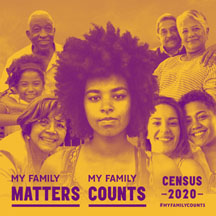On March 12, the U.S. Census Bureau mailed letters to tens of millions of U.S. households inviting the public to participate in the 2020 Census-- via the internet (for the first time in Census history), by phone or paper questionnaire. Unfortunately, COVID-19 emerged one week into the 2020 Census, wreaking havoc on Census operations and delaying critical enumeration efforts.
As Census addresses these issues, the self-response rate has been low, especially amongst Blacks. Overall, the estimated national self-response rate as of May 2020 was 57.7 percent. The response rate in majority Black areas is 47.6 percent. Furthermore, half of the U.S. foreign born population lives in Bronx, Brooklyn, and Queens, New York were the response rate is even lower, 39.7 percent.
Additionally, rural populations without internet access have not been fully enumerated, nor have college students sent home to shelter in place, or the homeless, our most vulnerable population.
Not only is the decennial census mandated in the U.S. Constitution, ensuring the apportionment of Congressional seats in the U.S. House of Representatives and the Electoral College, it provides local and state parameters for school districts, wards, parishes, Congressional districts, and more. Equally important, the census count determines the allocation of more than $1.2 trillion dollars in federal funding each year to communities nationwide for programs like SNAP, Section 8, TANF, school lunch programs, healthy baby nutritional programs, WIC, Head Start, Medicaid, hospitals, and public transportation subsidies.
COVID-19, the 2020 US Census, and You

Our communities will need these programs the most in a post COVID-19 environment as we rebuild. Last decade, the 2010 Census missed approximately 3.7 million Black people, nor were seven out of 10 Black children 0-5 years old counted. Worse, African American men were undercounted significantly in almost every age category.
A Black undercount in the 2020 Census will have devastating consequences in the aftermath of the Coronavirus pandemic as skyrocketing economic and healthcare needs have disproportionately affected Black communities. The current “Stay at Home” phase of the pandemic, coupled with the extended timeframe Census has provided for participating in the Census (until October 31, 2020), provide a valuable window of opportunity to encourage the public, especially African Americans and the diaspora to participate in the Census.
It’s easy to participate and not contribute to the 3.7 million who were missed in 2010. Go to www.my2020census.gov to fill out the form online or call toll-free: 844-330-2020.
Green last contributed the travel story "South Africa," in the August - October 2005 print issue.
A Black undercount in the 2020 Census will have devastating consequences in the aftermath of the Coronavirus pandemic as skyrocketing economic and healthcare needs have disproportionately affected Black communities. The current “Stay at Home” phase of the pandemic, coupled with the extended timeframe Census has provided for participating in the Census (until October 31, 2020), provide a valuable window of opportunity to encourage the public, especially African Americans and the diaspora to participate in the Census.
It’s easy to participate and not contribute to the 3.7 million who were missed in 2010. Go to www.my2020census.gov to fill out the form online or call toll-free: 844-330-2020.
Green last contributed the travel story "South Africa," in the August - October 2005 print issue.
Advertisers | Contact Us | Events | Links | Media Kit | Our Company | Payments Pier
Press Room | Print Cover Stories Archives | Electronic Issues and Talk Radio Archives | Writer's Guidelines






